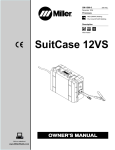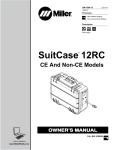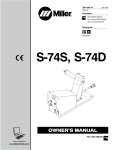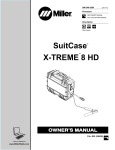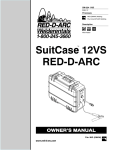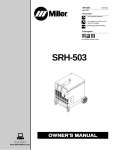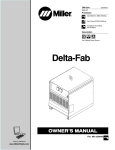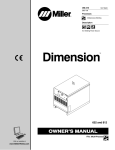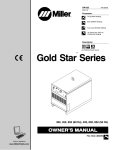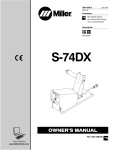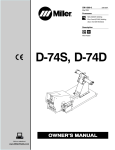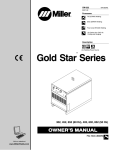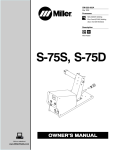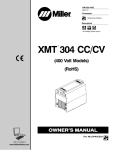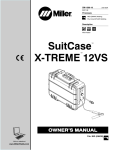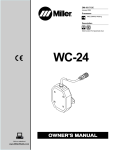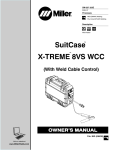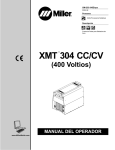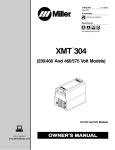Download Miller Electric SuitCase 8VS User's Manual
Transcript
OM-1599 200 624M 2005−11 Processes MIG (GMAW) Welding Flux Cored (FCAW) Welding Description Wire Feeder SuitCase 8VS File: MIG (GMAW) Visit our website at www.MillerWelds.com From Miller to You Thank you and congratulations on choosing Miller. Now you can get the job done and get it done right. We know you don’t have time to do it any other way. That’s why when Niels Miller first started building arc welders in 1929, he made sure his products offered long-lasting value and superior quality. Like you, his customers couldn’t afford anything less. Miller products had to be more than the best they could be. They had to be the best you could buy. Today, the people that build and sell Miller products continue the tradition. They’re just as committed to providing equipment and service that meets the high standards of quality and value established in 1929. This Owner’s Manual is designed to help you get the most out of your Miller products. Please take time to read the Safety precautions. They will help you protect yourself against potential hazards on the worksite. We’ve made installation and operation quick and easy. With Miller you can count on years of reliable service with proper maintenance. And if for some reason the unit needs repair, there’s a Troubleshooting section that will help you figure out what the problem is. The Miller is the first welding parts list will then help you to decide the equipment manufacturer in exact part you may need to fix the problem. the U.S.A. to be registered to the ISO 9001:2000 Quality Warranty and service information for your System Standard. particular model are also provided. Miller Electric manufactures a full line of welders and welding related equipment. For information on other quality Miller products, contact your local Miller distributor to receive the latest full line catalog or individual specification sheets. To locate your nearest distributor or service agency call 1-800-4-A-Miller, or visit us at www.MillerWelds.com on the web. Mil_Thank 4/05 Working as hard as you do − every power source from Miller is backed by the most hassle-free warranty in the business. TABLE OF CONTENTS SECTION 1 − SAFETY PRECAUTIONS - READ BEFORE USING . . . . . . . . . . . . . . . . . . . . . . . . . . . . . . . . . . . 1-1. Symbol Usage . . . . . . . . . . . . . . . . . . . . . . . . . . . . . . . . . . . . . . . . . . . . . . . . . . . . . . . . . . . . . . . . . . . . . . . . 1-2. Arc Welding Hazards . . . . . . . . . . . . . . . . . . . . . . . . . . . . . . . . . . . . . . . . . . . . . . . . . . . . . . . . . . . . . . . . . . 1-3. Additional Symbols For Installation, Operation, And Maintenance . . . . . . . . . . . . . . . . . . . . . . . . . . . . . 1-4. California Proposition 65 Warnings . . . . . . . . . . . . . . . . . . . . . . . . . . . . . . . . . . . . . . . . . . . . . . . . . . . . . . . 1-5. Principal Safety Standards . . . . . . . . . . . . . . . . . . . . . . . . . . . . . . . . . . . . . . . . . . . . . . . . . . . . . . . . . . . . . 1-6. EMF Information . . . . . . . . . . . . . . . . . . . . . . . . . . . . . . . . . . . . . . . . . . . . . . . . . . . . . . . . . . . . . . . . . . . . . . SECTION 2 − CONSIGNES DE SÉCURITÉ − À LIRE AVANT UTILISATION . . . . . . . . . . . . . . . . . . . . . . . . . . 2-1. Signification des symboles . . . . . . . . . . . . . . . . . . . . . . . . . . . . . . . . . . . . . . . . . . . . . . . . . . . . . . . . . . . . . 2-2. Dangers relatifs au soudage à l’arc . . . . . . . . . . . . . . . . . . . . . . . . . . . . . . . . . . . . . . . . . . . . . . . . . . . . . . 2-3. Autres symboles relatifs à l’installation, au fonctionnement et à l’entretien de l’appareil. . . . . . . . . . . . 2-4. Principales normes de sécurité . . . . . . . . . . . . . . . . . . . . . . . . . . . . . . . . . . . . . . . . . . . . . . . . . . . . . . . . . . 2-5. Information sur les champs électromagnétiques . . . . . . . . . . . . . . . . . . . . . . . . . . . . . . . . . . . . . . . . . . . . SECTION 3 − DEFINITIONS . . . . . . . . . . . . . . . . . . . . . . . . . . . . . . . . . . . . . . . . . . . . . . . . . . . . . . . . . . . . . . . . . . . 3-1. Warning Label Definitions . . . . . . . . . . . . . . . . . . . . . . . . . . . . . . . . . . . . . . . . . . . . . . . . . . . . . . . . . . . . . . 3-2. Manufacturer’s Rating Label For CE Products . . . . . . . . . . . . . . . . . . . . . . . . . . . . . . . . . . . . . . . . . . . . . 3-3. Symbols And Definitions . . . . . . . . . . . . . . . . . . . . . . . . . . . . . . . . . . . . . . . . . . . . . . . . . . . . . . . . . . . . . . . SECTION 4 − INSTALLATION . . . . . . . . . . . . . . . . . . . . . . . . . . . . . . . . . . . . . . . . . . . . . . . . . . . . . . . . . . . . . . . . . . 4-1. Specifications . . . . . . . . . . . . . . . . . . . . . . . . . . . . . . . . . . . . . . . . . . . . . . . . . . . . . . . . . . . . . . . . . . . . . . . . 4-2. Gun Recommendation Table . . . . . . . . . . . . . . . . . . . . . . . . . . . . . . . . . . . . . . . . . . . . . . . . . . . . . . . . . . . . 4-3. Equipment Connection Diagram . . . . . . . . . . . . . . . . . . . . . . . . . . . . . . . . . . . . . . . . . . . . . . . . . . . . . . . . . 4-4. Installing And Aligning Wire Guide And Drive Rolls . . . . . . . . . . . . . . . . . . . . . . . . . . . . . . . . . . . . . . . . . 4-5. Connecting Welding Gun And Voltage Sensing Clamp . . . . . . . . . . . . . . . . . . . . . . . . . . . . . . . . . . . . . . . 4-6. Connecting Shielding Gas . . . . . . . . . . . . . . . . . . . . . . . . . . . . . . . . . . . . . . . . . . . . . . . . . . . . . . . . . . . . . . 4-7. Connecting Weld Cable . . . . . . . . . . . . . . . . . . . . . . . . . . . . . . . . . . . . . . . . . . . . . . . . . . . . . . . . . . . . . . . . 4-8. Installing And Threading Welding Wire . . . . . . . . . . . . . . . . . . . . . . . . . . . . . . . . . . . . . . . . . . . . . . . . . . . . SECTION 5 − OPERATION . . . . . . . . . . . . . . . . . . . . . . . . . . . . . . . . . . . . . . . . . . . . . . . . . . . . . . . . . . . . . . . . . . . . 5-1. Controls For Non-CE Models . . . . . . . . . . . . . . . . . . . . . . . . . . . . . . . . . . . . . . . . . . . . . . . . . . . . . . . . . . . 5-2. Controls For CE Models . . . . . . . . . . . . . . . . . . . . . . . . . . . . . . . . . . . . . . . . . . . . . . . . . . . . . . . . . . . . . . . . SECTION 6 − MAINTENANCE & TROUBLESHOOTING . . . . . . . . . . . . . . . . . . . . . . . . . . . . . . . . . . . . . . . . . . . 6-1. Routine Maintenance . . . . . . . . . . . . . . . . . . . . . . . . . . . . . . . . . . . . . . . . . . . . . . . . . . . . . . . . . . . . . . . . . . 6-2. Overload Protection And Thermostat Protection . . . . . . . . . . . . . . . . . . . . . . . . . . . . . . . . . . . . . . . . . . . . 6-3. Troubleshooting . . . . . . . . . . . . . . . . . . . . . . . . . . . . . . . . . . . . . . . . . . . . . . . . . . . . . . . . . . . . . . . . . . . . . . SECTION 7 − ELECTRICAL DIAGRAMS . . . . . . . . . . . . . . . . . . . . . . . . . . . . . . . . . . . . . . . . . . . . . . . . . . . . . . . . SECTION 8 − PARTS LIST . . . . . . . . . . . . . . . . . . . . . . . . . . . . . . . . . . . . . . . . . . . . . . . . . . . . . . . . . . . . . . . . . . . . . OPTIONS AND ACCESSORIES WARRANTY 1 1 1 3 3 4 4 5 5 5 7 8 8 9 9 10 10 11 11 11 11 12 13 13 14 14 15 15 16 17 17 17 18 19 20 Declaration of Conformity for European Community (CE) Products NOTE This information is provided for units with CE certification (see rating label on unit). Manufacturer: European Contact: Miller Electric Mg. Co. 1635 W. Spencer St. Appleton, WI 54914 USA Phone: (920) 734-9821 Mr. Danilo Fedolfi, Managing Director ITW Welding Products Italy S.r.l. Via Privata Iseo 6/E 20098 San Giuliano Milanese, Italy Phone: 39(02)98290-1 Fax: 39(02)98290203 European Contact Signature: Declares that the product: SuitCase 8VS conforms to the following Directives and Standards: Directives Low Voltage Directive: 73/23/EEC Electromagnetic Compatibility (EMC) Directive: 89/336/EEC Machinery Directives: 98/37/EEC, 91/368/EEC, 92/31/EEC, 133/04, 93/68/EEC Standards Arc Welding Equipment − Part 5: Wire Feeders. IEC 60974-5 Ed. 1 Arc Welding Equipment − Part 10: Electromagnetic Compatibility (EMC) Requirements. IEC 60974-10 August 2002 Arc Welding Equipment − Part 1: Welding Power Sources. IEC 60974-1 Ed. 2.1 Degrees Of Protection Provided By Enclosure (IP Code) IEC 60529 Ed. 2.1 Insulation Coordination For Equipment Within Low-Voltage Systems − Part 1: Principles, Requirements and Tests: IEC 60664-1 Ed. 1.1 The product technical file is maintained by the responsible Business Unit(s) located at the manufacturing facility. dec_wire_6/05 SECTION 1 − SAFETY PRECAUTIONS - READ BEFORE USING som _3/05 Y Warning: Protect yourself and others from injury — read and follow these precautions. 1-1. Symbol Usage Means Warning! Watch Out! There are possible hazards with this procedure! The possible hazards are shown in the adjoining symbols. Y Marks a special safety message. . Means “Note”; not safety related. This group of symbols means Warning! Watch Out! possible ELECTRIC SHOCK, MOVING PARTS, and HOT PARTS hazards. Consult symbols and related instructions below for necessary actions to avoid the hazards. 1-2. Arc Welding Hazards Y The symbols shown below are used throughout this manual to call attention to and identify possible hazards. When you see the symbol, watch out, and follow the related instructions to avoid the hazard. The safety information given below is only a summary of the more complete safety information found in the Safety Standards listed in Section 1-5. Read and follow all Safety Standards. Y Only qualified persons should install, operate, maintain, and repair this unit. D D D D D D Y During operation, keep everybody, especially children, away. ELECTRIC SHOCK can kill. Touching live electrical parts can cause fatal shocks or severe burns. The electrode and work circuit is electrically live whenever the output is on. The input power circuit and machine internal circuits are also live when power is on. In semiautomatic or automatic wire welding, the wire, wire reel, drive roll housing, and all metal parts touching the welding wire are electrically live. Incorrectly installed or improperly grounded equipment is a hazard. D Do not touch live electrical parts. D Wear dry, hole-free insulating gloves and body protection. D Insulate yourself from work and ground using dry insulating mats or covers big enough to prevent any physical contact with the work or ground. D Do not use AC output in damp areas, if movement is confined, or if there is a danger of falling. D Use AC output ONLY if required for the welding process. D If AC output is required, use remote output control if present on unit. D Additional safety precautions are required when any of the following electrically hazardous conditions are present: in damp locations or while wearing wet clothing; on metal structures such as floors, gratings, or scaffolds; when in cramped positions such as sitting, kneeling, or lying; or when there is a high risk of unavoidable or accidental contact with the workpiece or ground. For these conditions, use the following equipment in order presented: 1) a semiautomatic DC constant voltage (wire) welder, 2) a DC manual (stick) welder, or 3) an AC welder with reduced open-circuit voltage. In most situations, use of a DC, constant voltage wire welder is recommended. And, do not work alone! D Disconnect input power or stop engine before installing or servicing this equipment. Lockout/tagout input power according to OSHA 29 CFR 1910.147 (see Safety Standards). D Properly install and ground this equipment according to its Owner’s Manual and national, state, and local codes. D Always verify the supply ground − check and be sure that input power cord ground wire is properly connected to ground terminal in disconnect box or that cord plug is connected to a properly grounded receptacle outlet. D When making input connections, attach proper grounding conductor first − double-check connections. D Frequently inspect input power cord for damage or bare wiring − replace cord immediately if damaged − bare wiring can kill. D D D D D D Turn off all equipment when not in use. Do not use worn, damaged, undersized, or poorly spliced cables. Do not drape cables over your body. If earth grounding of the workpiece is required, ground it directly with a separate cable. Do not touch electrode if you are in contact with the work, ground, or another electrode from a different machine. Do not touch electrode holders connected to two welding machines at the same time since double open-circuit voltage will be present. Use only well-maintained equipment. Repair or replace damaged parts at once. Maintain unit according to manual. Wear a safety harness if working above floor level. Keep all panels and covers securely in place. Clamp work cable with good metal-to-metal contact to workpiece or worktable as near the weld as practical. Insulate work clamp when not connected to workpiece to prevent contact with any metal object. Do not connect more than one electrode or work cable to any single weld output terminal. SIGNIFICANT DC VOLTAGE exists in inverter-type welding power sources after removal of input power. D Turn Off inverter, disconnect input power, and discharge input capacitors according to instructions in Maintenance Section before touching any parts. FUMES AND GASES can be hazardous. Welding produces fumes and gases. Breathing these fumes and gases can be hazardous to your health. D Keep your head out of the fumes. Do not breathe the fumes. D If inside, ventilate the area and/or use local forced ventilation at the arc to remove welding fumes and gases. D If ventilation is poor, wear an approved air-supplied respirator. D Read and understand the Material Safety Data Sheets (MSDSs) and the manufacturer’s instructions for metals, consumables, coatings, cleaners, and degreasers. D Work in a confined space only if it is well ventilated, or while wearing an air-supplied respirator. Always have a trained watchperson nearby. Welding fumes and gases can displace air and lower the oxygen level causing injury or death. Be sure the breathing air is safe. D Do not weld in locations near degreasing, cleaning, or spraying operations. The heat and rays of the arc can react with vapors to form highly toxic and irritating gases. D Do not weld on coated metals, such as galvanized, lead, or cadmium plated steel, unless the coating is removed from the weld area, the area is well ventilated, and while wearing an air-supplied respirator. The coatings and any metals containing these elements can give off toxic fumes if welded. OM-1599 Page 1 ARC RAYS can burn eyes and skin. Arc rays from the welding process produce intense visible and invisible (ultraviolet and infrared) rays that can burn eyes and skin. Sparks fly off from the weld. D Wear an approved welding helmet fitted with a proper shade of filter lenses to protect your face and eyes when welding or watching (see ANSI Z49.1 and Z87.1 listed in Safety Standards). D Wear approved safety glasses with side shields under your helmet. D Use protective screens or barriers to protect others from flash, glare and sparks; warn others not to watch the arc. D Wear protective clothing made from durable, flame-resistant material (leather, heavy cotton, or wool) and foot protection. WELDING can cause fire or explosion. Welding on closed containers, such as tanks, drums, or pipes, can cause them to blow up. Sparks can fly off from the welding arc. The flying sparks, hot workpiece, and hot equipment can cause fires and burns. Accidental contact of electrode to metal objects can cause sparks, explosion, overheating, or fire. Check and be sure the area is safe before doing any welding. D Remove all flammables within 35 ft (10.7 m) of the welding arc. If this is not possible, tightly cover them with approved covers. D Do not weld where flying sparks can strike flammable material. D Protect yourself and others from flying sparks and hot metal. D Be alert that welding sparks and hot materials from welding can easily go through small cracks and openings to adjacent areas. D Watch for fire, and keep a fire extinguisher nearby. D Be aware that welding on a ceiling, floor, bulkhead, or partition can cause fire on the hidden side. D Do not weld on closed containers such as tanks, drums, or pipes, unless they are properly prepared according to AWS F4.1 (see Safety Standards). D Connect work cable to the work as close to the welding area as practical to prevent welding current from traveling long, possibly unknown paths and causing electric shock, sparks, and fire hazards. D Do not use welder to thaw frozen pipes. D Remove stick electrode from holder or cut off welding wire at contact tip when not in use. D Wear oil-free protective garments such as leather gloves, heavy shirt, cuffless trousers, high shoes, and a cap. D Remove any combustibles, such as a butane lighter or matches, from your person before doing any welding. D Follow requirements in OSHA 1910.252 (a) (2) (iv) and NFPA 51B for hot work and have a fire watcher and extinguisher nearby. FLYING METAL can injure eyes. D Welding, chipping, wire brushing, and grinding cause sparks and flying metal. As welds cool, they can throw off slag. D Wear approved safety glasses with side shields even under your welding helmet. OM-1599 Page 2 BUILDUP OF GAS can injure or kill. D Shut off shielding gas supply when not in use. D Always ventilate confined spaces or use approved air-supplied respirator. HOT PARTS can cause severe burns. D Do not touch hot parts bare handed. D Allow cooling period before working on gun or torch. D To handle hot parts, use proper tools and/or wear heavy, insulated welding gloves and clothing to prevent burns. MAGNETIC FIELDS can affect pacemakers. D Pacemaker wearers keep away. D Wearers should consult their doctor before going near arc welding, gouging, or spot welding operations. NOISE can damage hearing. Noise from some processes or equipment can damage hearing. D Wear approved ear protection if noise level is high. CYLINDERS can explode if damaged. Shielding gas cylinders contain gas under high pressure. If damaged, a cylinder can explode. Since gas cylinders are normally part of the welding process, be sure to treat them carefully. D Protect compressed gas cylinders from excessive heat, mechanical shocks, physical damage, slag, open flames, sparks, and arcs. D Install cylinders in an upright position by securing to a stationary support or cylinder rack to prevent falling or tipping. D Keep cylinders away from any welding or other electrical circuits. D Never drape a welding torch over a gas cylinder. D Never allow a welding electrode to touch any cylinder. D Never weld on a pressurized cylinder − explosion will result. D Use only correct shielding gas cylinders, regulators, hoses, and fittings designed for the specific application; maintain them and associated parts in good condition. D Turn face away from valve outlet when opening cylinder valve. D Keep protective cap in place over valve except when cylinder is in use or connected for use. D Use the right equipment, correct procedures, and sufficient number of persons to lift and move cylinders. D Read and follow instructions on compressed gas cylinders, associated equipment, and Compressed Gas Association (CGA) publication P-1 listed in Safety Standards. 1-3. Additional Symbols For Installation, Operation, And Maintenance FIRE OR EXPLOSION hazard. MOVING PARTS can cause injury. D Do not install or place unit on, over, or near combustible surfaces. D Do not install unit near flammables. D Do not overload building wiring − be sure power supply system is properly sized, rated, and protected to handle this unit. D Keep away from moving parts such as fans. D Keep all doors, panels, covers, and guards closed and securely in place. D Have only qualified persons remove doors, panels, covers, or guards for maintenance as necessary. D Reinstall doors, panels, covers, or guards when maintenance is finished and before reconnecting input power. FALLING UNIT can cause injury. D Use lifting eye to lift unit only, NOT running gear, gas cylinders, or any other accessories. D Use equipment of adequate capacity to lift and support unit. D If using lift forks to move unit, be sure forks are long enough to extend beyond opposite side of unit. READ INSTRUCTIONS. D Read Owner’s Manual before using or servicing unit. D Use only genuine Miller/Hobart replacement parts. H.F. RADIATION can cause interference. OVERUSE can cause OVERHEATING D Allow cooling period; follow rated duty cycle. D Reduce current or reduce duty cycle before starting to weld again. D Do not block or filter airflow to unit. D D STATIC (ESD) can damage PC boards. D Put on grounded wrist strap BEFORE handling boards or parts. D Use proper static-proof bags and boxes to store, move, or ship PC boards. D D D High-frequency (H.F.) can interfere with radio navigation, safety services, computers, and communications equipment. D Have only qualified persons familiar with electronic equipment perform this installation. The user is responsible for having a qualified electrician promptly correct any interference problem resulting from the installation. If notified by the FCC about interference, stop using the equipment at once. Have the installation regularly checked and maintained. Keep high-frequency source doors and panels tightly shut, keep spark gaps at correct setting, and use grounding and shielding to minimize the possibility of interference. ARC WELDING can cause interference. MOVING PARTS can cause injury. D Keep away from moving parts. D Keep away from pinch points such as drive rolls. D WELDING WIRE can cause injury. D Do not press gun trigger until instructed to do so. D Do not point gun toward any part of the body, other people, or any metal when threading welding wire. D D D D Electromagnetic energy can interfere with sensitive electronic equipment such as computers and computer-driven equipment such as robots. D Be sure all equipment in the welding area is electromagnetically compatible. To reduce possible interference, keep weld cables as short as possible, close together, and down low, such as on the floor. Locate welding operation 100 meters from any sensitive electronic equipment. Be sure this welding machine is installed and grounded according to this manual. If interference still occurs, the user must take extra measures such as moving the welding machine, using shielded cables, using line filters, or shielding the work area. 1-4. California Proposition 65 Warnings Y Welding or cutting equipment produces fumes or gases which contain chemicals known to the State of California to cause birth defects and, in some cases, cancer. (California Health & Safety Code Section 25249.5 et seq.) For Gasoline Engines: Y Engine exhaust contains chemicals known to the State of California to cause cancer, birth defects, or other reproductive harm. Y Battery posts, terminals and related accessories contain lead and lead compounds, chemicals known to the State of California to cause cancer and birth defects or other reproductive harm. Wash hands after handling. For Diesel Engines: Y Diesel engine exhaust and some of its constituents are known to the State of California to cause cancer, birth defects, and other reproductive harm. OM-1599 Page 3 1-5. Principal Safety Standards Safety in Welding, Cutting, and Allied Processes, ANSI Standard Z49.1, from Global Engineering Documents (phone: 1-877-413-5184, website: www.global.ihs.com). Boulevard, Rexdale, Ontario, Canada M9W 1R3 (phone: 800−463−6727 or in Toronto 416−747−4044, website: www.csa−international.org). Recommended Safe Practices for the Preparation for Welding and Cutting of Containers and Piping, American Welding Society Standard AWS F4.1 from Global Engineering Documents (phone: 1-877-413-5184, website: www.global.ihs.com). Practice For Occupational And Educational Eye And Face Protection, ANSI Standard Z87.1, from American National Standards Institute, 11 West 42nd Street, New York, NY 10036−8002 (phone: 212−642−4900, website: www.ansi.org). National Electrical Code, NFPA Standard 70, from National Fire Protection Association, P.O. Box 9101, 1 Battery March Park, Quincy, MA 02269−9101 (phone: 617−770−3000, website: www.nfpa.org). Standard for Fire Prevention During Welding, Cutting, and Other Hot Work, NFPA Standard 51B, from National Fire Protection Association, P.O. Box 9101, 1 Battery March Park, Quincy, MA 02269−9101 (phone: 617−770−3000,website: www.nfpa.org). Safe Handling of Compressed Gases in Cylinders, CGA Pamphlet P-1, from Compressed Gas Association, 1735 Jefferson Davis Highway, Suite 1004, Arlington, VA 22202−4102 (phone: 703−412−0900, website: www.cganet.com). Code for Safety in Welding and Cutting, CSA Standard W117.2, from Canadian Standards Association, Standards Sales, 178 Rexdale OSHA, Occupational Safety and Health Standards for General Industry, Title 29, Code of Federal Regulations (CFR), Part 1910, Subpart Q, and Part 1926, Subpart J, from U.S. Government Printing Office, Superintendent of Documents, P.O. Box 371954, Pittsburgh, PA 15250 (there are 10 Regional Offices−−phone for Region 5, Chicago, is 312−353−2220,website: www.osha.gov). 1-6. EMF Information Considerations About Welding And The Effects Of Low Frequency Electric And Magnetic Fields Welding current, as it flows through welding cables, will cause electromagnetic fields. There has been and still is some concern about such fields. However, after examining more than 500 studies spanning 17 years of research, a special blue ribbon committee of the National Research Council concluded that: “The body of evidence, in the committee’s judgment, has not demonstrated that exposure to powerfrequency electric and magnetic fields is a human-health hazard.” However, studies are still going forth and evidence continues to be examined. Until the final conclusions of the research are reached, you may wish to minimize your exposure to electromagnetic fields when welding or cutting. To reduce magnetic fields in the workplace, use the following procedures: OM-1599 Page 4 1. Keep cables close together by twisting or taping them. 2. Arrange cables to one side and away from the operator. 3. Do not coil or drape cables around your body. 4. Keep welding power source and cables as far away from operator as practical. 5. Connect work clamp to workpiece as close to the weld as possible. About Pacemakers: Pacemaker wearers consult your doctor before welding or going near welding operations. If cleared by your doctor, then following the above procedures is recommended. SECTION 2 − CONSIGNES DE SÉCURITÉ − LIRE AVANT UTILISATION som _3/05 Y Avertissement : se protéger et protéger les autres contre le risque de blessure — lire et respecter ces consignes. 2-1. Symboles utilisés Symbole graphique d’avertissement ! Attention ! Cette procédure comporte des risques possibles ! Les dangers éventuels sont représentés par les symboles graphiques joints. Y Indique un message de sécurité particulier . Signifie NOTE ; n’est pas relatif à la sécurité. 2-2. Ce groupe de symboles signifie Avertissement ! Attention ! Risques d’ÉLECTROCUTION, ORGANES MOBILES et PARTIES CHAUDES. Consulter les symboles et les instructions afférentes ci-dessous concernant les mesures à prendre pour supprimer les dangers. Dangers relatifs au soudage à l’arc Y Les symboles représentés ci-dessous sont utilisés dans ce manuel pour attirer l’attention et identifier les dangers possibles. En présence de l’un de ces symboles, prendre garde et suivre les instructions afférentes pour éviter tout risque. Les instructions en matière de sécurité indiquées ci-dessous ne constituent qu’un sommaire des instructions de sécurité plus complètes fournies dans les normes de sécurité énumérées dans la Section 2-5. Lire et observer toutes les normes de sécurité. Y Seul un personnel qualifié est autorisé à installer, faire fonctionner, entretenir et réparer cet appareil. Y Pendant le fonctionnement, maintenir à distance toutes les personnes, notamment les enfants de l’appareil. D Vérifier fréquemment le cordon d’alimentation afin de s’assurer qu’il D D D D D D UNE DÉCHARGE ÉLECTRIQUE peut entraîner la mort. D Le contact d’organes électriques sous tension peut provoquer des accidents mortels ou des brûlures graves. Le circuit de l’électrode et de la pièce est sous tension lorsque le courant est délivré à la sortie. Le circuit d’alimentation et les circuits internes de la machine sont également sous tension lorsque l’alimentation est sur Marche. Dans le mode de soudage avec du fil, le fil, le dérouleur, le bloc de commande du rouleau et toutes les parties métalliques en contact avec le fil sont sous tension électrique. Un équipement installé ou mis à la terre de manière incorrecte ou impropre constitue un danger. D D D Ne pas toucher aux pièces électriques sous tension. D Porter des gants isolants et des vêtements de protection secs et sans D D D D D D D D D trous. S’isoler de la pièce à couper et du sol en utilisant des housses ou des tapis assez grands afin d’éviter tout contact physique avec la pièce à couper ou le sol. Ne pas se servir de source électrique à courant électrique dans les zones humides, dans les endroits confinés ou là où on risque de tomber. Se servir d’une source électrique à courant électrique UNIQUEMENT si le procédé de soudage le demande. Si l’utilisation d’une source électrique à courant électrique s’avère nécessaire, se servir de la fonction de télécommande si l’appareil en est équipé. D’autres consignes de sécurité sont nécessaires dans les conditions suivantes : risques électriques dans un environnement humide ou si l’on porte des vêtements mouillés ; sur des structures métalliques telles que sols, grilles ou échafaudages ; en position coincée comme assise, à genoux ou couchée ; ou s’il y a un risque élevé de contact inévitable ou accidentel avec la pièce à souder ou le sol. Dans ces conditions, utiliser les équipements suivants, dans l’ordre indiqué : 1) un poste à souder DC à tension constante (à fil), 2) un poste à souder DC manuel (électrode) ou 3) un poste à souder AC à tension à vide réduite. Dans la plupart des situations, l’utilisation d’un poste à souder DC à fil à tension constante est recommandée. En outre, ne pas travailler seul ! Couper l’alimentation ou arrêter le moteur avant de procéder à l’installation, à la réparation ou à l’entretien de l’appareil. Déverrouiller l’alimentation selon la norme OSHA 29 CFR 1910.147 (voir normes de sécurité). Installer le poste correctement et le mettre à la terre convenablement selon les consignes du manuel de l’opérateur et les normes nationales, provinciales et locales. Toujours vérifier la terre du cordon d’alimentation. Vérifier et s’assurer que le fil de terre du cordon d’alimentation est bien raccordé à la borne de terre du sectionneur ou que la fiche du cordon est raccordée à une prise correctement mise à la terre. En effectuant les raccordements d’entrée, fixer d’abord le conducteur de mise à la terre approprié et contre-vérifier les connexions. D D D n’est pas altéré ou à nu, le remplacer immédiatement s’il l’est. Un fil à nu peut entraîner la mort. L’équipement doit être hors tension lorsqu’il n’est pas utilisé. Ne pas utiliser des câbles usés, endommagés, de grosseur insuffisante ou mal épissés. Ne pas enrouler les câbles autour du corps. Si la pièce soudée doit être mise à la terre, le faire directement avec un câble distinct. Ne pas toucher l’électrode quand on est en contact avec la pièce, la terre ou une électrode provenant d’une autre machine. Ne pas toucher des porte électrodes connectés à deux machines en même temps à cause de la présence d’une tension à vide doublée. N’utiliser qu’un matériel en bon état. Réparer ou remplacer sur-lechamp les pièces endommagées. Entretenir l’appareil conformément à ce manuel. Porter un harnais de sécurité si l’on doit travailler au-dessus du sol. S’assurer que tous les panneaux et couvercles sont correctement en place. Fixer le câble de retour de façon à obtenir un bon contact métal-métal avec la pièce à souder ou la table de travail, le plus près possible de la soudure. Isoler la pince de masse quand pas mis à la pièce pour éviter le contact avec tout objet métallique. Ne pas raccorder plus d’une électrode ou plus d’un câble de masse à une même borne de sortie de soudage. Il reste une TENSION DC NON NÉGLIGEABLE dans les sources de soudage onduleur quand on a coupé l’alimentation. D Arrêter les convertisseurs, débrancher le courant électrique et décharger les condensateurs d’alimentation selon les instructions indiquées dans la partie Entretien avant de toucher les pièces. LES FUMÉES ET LES GAZ peuvent être dangereux. Le soudage génère des fumées et des gaz. Leur inhalation peut être dangereuse pour la santé. D Ne pas mettre sa tête au-dessus des vapeurs. Ne pas respirer ces vapeurs. D À l’intérieur, ventiler la zone et/ou utiliser une ventilation forcée au niveau de l’arc pour l’évacuation des fumées et des gaz de soudage. D Si la ventilation est médiocre, porter un respirateur anti-vapeurs approuvé. D Lire et comprendre les spécifications de sécurité des matériaux (MSDS) et les instructions du fabricant concernant les métaux, les consommables, les revêtements, les nettoyants et les dégraisseurs. D Travailler dans un espace fermé seulement s’il est bien ventilé ou en portant un respirateur à alimentation d’air. Demander toujours à un surveillant dûment formé de se tenir à proximité. Des fumées et des gaz de soudage peuvent déplacer l’air et abaisser le niveau d’oxygène provoquant des blessures ou des accidents mortels. S’assurer que l’air de respiration ne présente aucun danger. D Ne pas souder dans des endroits situés à proximité d’opérations de dégraissage, de nettoyage ou de pulvérisation. La chaleur et les rayons de l’arc peuvent réagir en présence de vapeurs et former des gaz hautement toxiques et irritants. D Ne pas souder des métaux munis d’un revêtement, tels que l’acier galvanisé, plaqué en plomb ou au cadmium à moins que le revêtement n’ait été enlevé dans la zone de soudure, que l’endroit soit bien ventilé et en portant un respirateur à alimentation d’air. Les revêtements et tous les métaux renfermant ces éléments peuvent dégager des fumées toxiques en cas de soudage. OM-1599 Page 5 LES RAYONS D’ARC peuvent entraîner des brûlures aux yeux et à la peau. Le rayonnement de l’arc du procédé de soudage génère des rayons visibles et invisibles intenses (ultraviolets et infrarouges) susceptibles de provoquer des brûlures dans les yeux et sur la peau. Des étincelles sont projetées pendant le soudage. D Porter un casque de soudage approuvé muni de verres filtrants approprié pour protéger visage et yeux pendant le soudage (voir ANSI Z49.1 et Z87.1 énuméré dans les normes de sécurité). D Porter des lunettes de sécurité avec écrans latéraux même sous votre casque. D Avoir recours à des écrans protecteurs ou à des rideaux pour protéger les autres contre les rayonnements les éblouissements et les étincelles ; prévenir toute personne sur les lieux de ne pas regarder l’arc. D Porter des vêtements confectionnés avec des matières résistantes et ignifuges (cuir, coton lourd ou laine) et des bottes de protection. LE SOUDAGE peut provoquer un incendie ou une explosion. Le soudage effectué sur des conteneurs fermés tels que des réservoirs, tambours ou des conduites peut provoquer leur éclatement. Des étincelles peuvent être projetées de l’arc de soudure. La projection d’étincelles, des pièces chaudes et des équipements chauds peuvent provoquer des incendies et des brûlures. Le contact accidentel de l’électrode avec des objets métalliques peut provoquer des étincelles, une explosion, une surchauffe ou un incendie. Avant de commencer le soudage, vérifier et s’assurer que l’endroit ne présente pas de danger. D Déplacer toutes les substances inflammables à une distance de 10,7 m de l’arc de soudage. En cas d’impossibilité, les recouvrir soigneusement avec des protections homologuées. D Ne pas souder dans un endroit où des étincelles peuvent tomber sur des substances inflammables. D Se protéger, ainsi que toute autre personne travaillant sur les lieux, contre les étincelles et le métal chaud. D Des étincelles et des matériaux chauds du soudage peuvent facilement passer dans d’autres zones en traversant de petites fissures et des ouvertures. D Afin d’éliminer tout risque de feu, être vigilant et garder toujours un extincteur à la portée de main. D Le soudage effectué sur un plafond, plancher, paroi ou séparation peut déclencher un incendie de l’autre côté. D Ne pas effectuer le soudage sur des conteneurs fermés tels que des réservoirs, tambours, ou conduites, à moins qu’ils n’aient été préparés correctement conformément à AWS F4.1 (voir les normes de sécurité). D Brancher le câble de masse sur la pièce le plus près possible de la zone de soudage pour éviter le transport du courant sur une longue distance par des chemins inconnus éventuels en provoquant des risques d’électrocution, d’étincelles et d’incendie. D Ne pas utiliser le poste de soudage pour dégeler des conduites gelées. D En cas de non-utilisation, enlever la baguette d’électrode du porteélectrode ou couper le fil à la pointe de contact. D Porter des vêtements de protection exempts d’huile tels que des gants en cuir, une veste résistante, des pantalons sans revers, des bottes et un casque. D Avant de souder, retirer toute substance combustible de ses poches telles qu’un allumeur au butane ou des allumettes. D Suivre les consignes de OSHA 1910.252 (a) (2) (iv) et de NFPA 51B pour travaux de soudage et prévoir un détecteur d’incendie et un extincteur à proximité. DES PARTICULES VOLANTES peuvent blesser les yeux. D Le soudage, l’écaillement, le passage de la pièce à la brosse en fil de fer, et le meulage génèrent des étincelles et des particules métalliques volantes. Pendant la période de refroidissement des soudures, elles risquent de projeter du laitier. D Porter des lunettes de sécurité avec écrans latéraux ou un écran facial. OM-1599 Page 6 LES ACCUMULATIONS DE GAZ risquent de provoquer des blessures ou même la mort. D Fermer l’alimentation du gaz protecteur en cas de non-utilisation. D Veiller toujours à bien aérer les espaces confinés ou se servir d’un respirateur d’adduction d’air homologué. DES PIÈCES CHAUDES peuvent provoquer des brûlures graves. D Ne pas toucher des parties chaudes à mains nues. D Prévoir une période de refroidissement avant d’utiliser le pistolet ou la torche. D Ne pas toucher aux pièces chaudes, utiliser les outils recommandés et porter des gants de soudage et des vêtements épais pour éviter les brûlures. LES CHAMPS MAGNÉTIQUES peuvent affecter les stimulateurs cardiaques. D Porteurs de stimulateur cardiaque, rester à distance. D Les porteurs d’un stimulateur cardiaque doivent d’abord consulter leur médecin avant de s’approcher des opérations de soudage à l’arc, de gougeage ou de soudage par points. LE BRUIT peut endommager l’ouïe. Le bruit des processus et des équipements peut affecter l’ouïe. D Porter des protections approuvées pour les oreilles si le niveau sonore est trop élevé. LES BOUTEILLES peuvent exploser si elles sont endommagées. Des bouteilles de gaz protecteur contiennent du gaz sous haute pression. Si une bouteille est endommagée, elle peut exploser. Du fait que les bouteilles de gaz font normalement partie du procédé de soudage, les manipuler avec précaution. D Protéger les bouteilles de gaz comprimé d’une chaleur excessive, des chocs mécaniques, des dommages physiques, du laitier, des flammes ouvertes, des étincelles et des arcs. D Placer les bouteilles debout en les fixant dans un support stationnaire ou dans un porte-bouteilles pour les empêcher de tomber ou de se renverser. D Tenir les bouteilles éloignées des circuits de soudage ou autres circuits électriques. D Ne jamais placer une torche de soudage sur une bouteille à gaz. D Une électrode de soudage ne doit jamais entrer en contact avec une bouteille. D Ne jamais souder une bouteille pressurisée − risque d’explosion. D Utiliser seulement des bouteilles de gaz protecteur, régulateurs, tuyaux et raccords convenables pour cette application spécifique ; les maintenir ainsi que les éléments associés en bon état. D Détourner votre visage du détendeur-régulateur lorsque vous ouvrez la soupape de la bouteille. D Le couvercle du détendeur doit toujours être en place, sauf lorsque la bouteille est utilisée ou qu’elle est reliée pour usage ultérieur. D Utiliser les équipements corrects, les bonnes procédures et suffisamment de personnes pour soulever et déplacer les bouteilles. D Lire et suivre les instructions sur les bouteilles de gaz comprimé, l’équipement connexe et le dépliant P-1 de la CGA (Compressed Gas Association) mentionné dans les principales normes de sécurité. 2-3. Dangers supplémentaires en relation avec l’installation, le fonctionnement et la maintenance Risque D’INCENDIE OU D’EXPLOSION. DES ORGANES MOBILES peuvent provoquer des blessures. D Ne pas placer l’appareil sur, au-dessus ou à proximité de surfaces inflammables. D Ne pas installer l’appareil à proximité de produits inflammables. D Ne pas surcharger l’installation électrique − s’assurer que l’alimentation est correctement dimensionnée et protégée avant de mettre l’appareil en service. D S’abstenir de toucher des organes mobiles tels que des ventilateurs. D Maintenir fermés et verrouillés les portes, panneaux, recouvrements et dispositifs de protection. D Seules des personnes qualifiées sont autorisées à enlever les portes, panneaux, recouvrements ou dispositifs de protection pour l’entretien. D Remettre les portes, panneaux, recouvrements ou dispositifs de protection quand l’entretien est terminé et avant de rebrancher l’alimentation électrique. LA CHUTE DE L’APPAREIL peut blesser. LIRE LES INSTRUCTIONS. D Utiliser l’anneau de levage uniquement pour soulever l’appareil, NON PAS les chariots, les bouteilles de gaz ou tout autre accessoire. D Utiliser un équipement de levage de capacité suffisante pour lever l’appareil. D En utilisant des fourches de levage pour déplacer l’unité, s’assurer que les fourches sont suffisamment longues pour dépasser du côté opposé de l’appareil. L’EMPLOI EXCESSIF peut CHAUFFER L’ÉQUIPEMENT. D Lire le manuel d’utilisation avant d’utiliser ou d’intervenir sur l’appareil. D Utiliser uniquement des pièces de rechange Miller/Hobart. LE RAYONNEMENT HAUTE FRÉQUENCE (HF) risque de provoquer des interférences. SUR- D Prévoir une période de refroidissement ; respecter le cycle opératoire nominal. D Réduire le courant ou le facteur de marche avant de poursuivre le soudage. D Ne pas obstruer les passages d’air du poste. D D D LES CHARGES ÉLECTROSTATIQUES peuvent endommager les circuits imprimés. D D D Établir la connexion avec la barrette de terre avant de manipuler des cartes ou des pièces. D Utiliser des pochettes et des boîtes antistatiques pour stocker, déplacer ou expédier des cartes PC. LE SOUDAGE À L’ARC risque de provoquer des interférences. DES ORGANES MOBILES peuvent provoquer des blessures. D Ne pas s’approcher des organes mobiles. D Ne pas s’approcher des points de coincement tels que des rouleaux de commande. D D LES FILS DE SOUDAGE peuvent provoquer des blessures. D D Ne pas appuyer sur la gâchette avant d’en avoir reçu l’instruction. D Ne pas diriger le pistolet vers soi, d’autres personnes ou toute pièce mécanique en engageant le fil de soudage. 2-4. D Le rayonnement haute fréquence (HF) peut provoquer des interférences avec les équipements de radio-navigation et de communication, les services de sécurité et les ordinateurs. Demander seulement à des personnes qualifiées familiarisées avec des équipements électroniques de faire fonctionner l’installation. L’utilisateur est tenu de faire corriger rapidement par un électricien qualifié les interférences résultant de l’installation. Si le FCC signale des interférences, arrêter immédiatement l’appareil. Effectuer régulièrement le contrôle et l’entretien de l’installation. Maintenir soigneusement fermés les portes et les panneaux des sources de haute fréquence, maintenir les éclateurs à une distance correcte et utiliser une terre et un blindage pour réduire les interférences éventuelles. D D L’énergie électromagnétique peut gêner le fonctionnement d’appareils électroniques comme des ordinateurs et des robots. D Veiller à ce que tout l’équipement de la zone de soudage soit compatible électromagnétiquement. Pour réduire la possibilité d’interférence, maintenir les câbles de soudage aussi courts que possible, les grouper, et les poser aussi bas que possible (ex. par terre). Veiller à souder à une distance de 100 mètres de tout équipement électronique sensible. Veiller à ce que ce poste de soudage soit posé et mis à la terre conformément à ce mode d’emploi. En cas d’interférences après avoir pris les mesures précédentes, il incombe à l’utilisateur de prendre des mesures supplémentaires telles que le déplacement du poste, l’utilisation de câbles blindés, l’utilisation de filtres de ligne ou la pose de protecteurs dans la zone de travail. Proposition californienne 65 Avertissements Y Les équipements de soudage et de coupage produisent des fumées et des gaz qui contiennent des produits chimiques dont l’État de Californie reconnaît qu’ils provoquent des malformations congénitales et, dans certains cas, des cancers. (Code de santé et de sécurité de Californie, chapitre 25249.5 et suivants) Pour les moteurs à essence : Y Les gaz d’échappement des moteurs contiennent des produits chimiques dont l’État de Californie reconnaît qu’ils provoquent des cancers et des malformations congénitales ou autres problèmes de procréation. Y Les batteries, les bornes et autres accessoires contiennent du plomb et des composés à base de plomb, produits chimiques dont l’État de Californie reconnaît qu’ils provoquent des cancers et des malformations congénitales ou autres problèmes de procréation. Se laver les mains après manipulation. Pour les moteurs diesel : Y Les gaz d’échappement des moteurs diesel et certains de leurs composants sont reconnus par l’État de Californie comme provoquant des cancers et des malformations congénitales ou autres problèmes de procréation. OM-1599 Page 7 2-5. Principales normes de sécurité Safety in Welding, Cutting, and Allied Processes, ANSI Standard Z49.1, de Global Engineering Documents (téléphone : 1-877-413-5184, site Internet : www.global.ihs.com). Boulevard, Rexdale, Ontario, Canada M9W 1R3 (téléphone : 800-463-6727 ou à Toronto 416-747-4044, site Internet : www.csa-international.org). Recommended Safe Practices for the Preparation for Welding and Cutting of Containers and Piping, American Welding Society Standard AWS F4.1 de Global Engineering Documents (téléphone : 1-877-413-5184, site Internet : www.global.ihs.com). Practice For Occupational And Educational Eye And Face Protection, ANSI Standard Z87.1, de American National Standards Institute, 11 West 42nd Street, New York, NY 10036-8002 (téléphone : 212-642-4900, site Internet : www.ansi.org). National Electrical Code, NFPA Standard 70, de National Fire Protection Association, P.O. Box 9101, 1 Battery March Park, Quincy, MA 02269-9101 (téléphone : 617-770-3000, site Internet : www.nfpa.org). Standard for Fire Prevention During Welding, Cutting, and Other Hot Work, NFPA Standard 51B, de National Fire Protection Association, P.O. Box 9101, 1 Battery March Park, Quincy, MA 02269-9101 (téléphone : 617-770-3000, site Internet : www.nfpa.org). Safe Handling of Compressed Gases in Cylinders, CGA Pamphlet P-1, de Compressed Gas Association, 1735 Jefferson Davis Highway, Suite 1004, Arlington, VA 22202-4102 (téléphone : 703-412-0900, site Internet : www.cganet.com). Code for Safety in Welding and Cutting, CSA Standard W117.2, de Canadian Standards Association, Standards Sales, 178 Rexdale 2-6. OSHA, Occupational Safety and Health Standards for General Industry, Title 29, Code of Federal Regulations (CFR), Part 1910, Subpart Q, and Part 1926, Subpart J, de U.S. Government Printing Office, Superintendent of Documents, P.O. Box 371954, Pittsburgh, PA 15250 (il y a 10 bureaux régionaux−−le téléphone de la région 5, Chicago, est 312-353-2220, site Internet : www.osha.gov). Information EMF Considérations sur le soudage et les effets de basse fréquence et des champs magnétiques et électriques. Le courant de soudage, pendant son passage dans les câbles de soudage, causera des champs électromagnétiques. Il y a eu et il y a encore un certain souci à propos de tels champs. Cependant, après avoir examiné plus de 500 études qui ont été faites pendant une période de recherche de 17 ans, un comité spécial ruban bleu du National Research Council a conclu : « L’accumulation de preuves, suivant le jugement du comité, n’a pas démontré que l’exposition aux champs magnétiques et champs électriques à haute fréquence représente un risque à la santé humaine ». Toutefois, des études sont toujours en cours et les preuves continuent à être examinées. En attendant que les conclusions finales de la recherche soient établies, il vous serait souhaitable de réduire votre exposition aux champs électromagnétiques pendant le soudage ou le coupage. Pour réduire les champs magnétiques sur le poste de travail, appliquer les procédures suivantes : OM-1599 Page 8 1. Maintenir les câbles ensemble en les tordant ou en les enveloppant. 2. Disposer les câbles d’un côté et à distance de l’opérateur. 3. Ne pas courber pas et ne pas entourer pas les câbles autour de votre corps. 4. Garder le poste de soudage et les câbles le plus loin possible de vous. 5. Connecter la pince sur la pièce aussi près que possible de la soudure. En ce qui concerne les stimulateurs cardiaques Les porteurs de stimulateur cardiaque doivent consulter leur médecin avant de souder ou d’approcher des opérations de soudage. Si le médecin approuve, il est recommandé de suivre les procédures précédentes. SECTION 3 − DEFINITIONS 3-1. Warning Label Definitions Warning! Watch Out! There are possible hazards as shown by the symbols. Drive rolls can injure fingers Welding wire and drive parts are at welding voltage during operation − keep hands and metal objects clear. 1 1.1 2 2.1 3 3.1 4 4.1 5 + 1.2 2.2 1.3 2.3 3.2 + 3.3 + + 6 S-178 936 1 Electric shock can kill. 1.1 Wear dry insulating gloves. Do not touch electrode with bare hand. Do not wear wet or damaged gloves. 1.2 Protect yourself from electric shock by insulating yourself from work and ground. 1.3 Disconnect input plug or power before working on machine. 2 Breathing welding fumes can be hazardous to your health. 2.1 Keep your head out of the fumes. 2.2 Use forced ventilation or local exhaust to remove the fumes. 2.3 Use ventilating fan to remove fumes. 3 Welding sparks can cause explosion or fire. 3.1 Keep flammables away from welding. Don’t weld near flammables. 3.2 Welding sparks can cause fires. Have a fire extinguisher nearby and have a watch person ready to use it. 3.3 Do not weld on drums or any closed containers. 4 Arc rays can burn eyes and injure skin. 4.1 Wear hat and safety glasses. Use ear protection and button shirt collar. Use welding helmet with correct shade of filter. Wear complete body protection. 5 Become trained and read the instructions before working on the machine or welding. 6 Do not remove or paint over (cover) the label. OM-1599 Page 9 3-2. Manufacturer’s Rating Label For CE Products For label location see Section 5-1. S/N: Hz DC IP 23 U1 100 V =I1= 7.0 A U2 100 V = I2= 500 A X 100 % ST-181 678 3-3. Symbols And Definitions NOTE Some symbols are found only on CE products. Duty Cycle Wire Feed Percent Input Cold Jog (Inch) Towards Workpiece Purge By Gas Fast Constant Current Circuit Breaker Constant Voltage Slow Trigger Hold Off Trigger Hold On Rated Welding Current Increase Read Instructions Primary Current OM-1599 Page 10 U1 Primary Voltage I2 U2 Amperes V IP Input X I1 A Output Conventional Load Voltage Hz Volts Degree Of Protection Hertz SECTION 4 − INSTALLATION 4-1. Specifications Welding Power Source Type Type of Input Power Open-Circuit/ Arc Voltage, 15 − 100 Volts DC Constant Voltage (CV) Or Constant Current (CC) DC Wire Feed Speed Range Wire Type And Diameter 50 − 700 ipm (1.3 − 18 mpm) Depending On Arc Voltage Solid Steel: .023 − .062 in (0.6 − 1.6 mm); Stainless Steel: .023 − .052 in (0.6 − 1.3 mm); Flux Cored: .030 − .052 in (0.8 − 1.3 mm) Input Welding Circuit Rating Max. Wire Spool Capacity IP Rating Overall Dimensions Weight Length: 15-5/8 in (397 mm) 330 Amperes At 60% Duty Cycle 23 14 lb (6.4 kg), 8 in (203 mm) Width: 6-1/2 in (165 mm) 25 lb (11 kg) Height: 14-1/2 in (368 mm) 4-2. Gun Recommendation Table Process Gun GMAW − Hard or Corded Wires M25 Or M40 FCAW − Self-Shielding Wires FC-1260 4-3. Equipment Connection Diagram Y Turn Off wire feeder and welding power source. Stop engine on welding generator. 1 Constant Current (CC) or Constant Voltage (CV) Welding Power Supply 2 Negative (−) Weld Cable 3 Positive (+) Weld Cable 4 Workpiece 5 Wire Feeder 6 Voltage Sensing Clamp 7 Gun 8 Gun Trigger Receptacle 9 Gas Hose 10 Gas Cylinder 1 10 2 5 3 9 4 6 8 7 803 625-A OM-1599 Page 11 4-4. Installing And Aligning Wire Guide And Drive Rolls Installing Wire Guide And Drive Rolls: 1 2 Drive Roll Nut Drive Roll Carrier Turn nut one click until lobes of nut line up with lobes of drive roll carrier. 3 Drive Roll Slide drive roll onto drive roll carrier. Turn nut one click. Repeat procedure for top drive roll. 4 5 Inlet Wire Guide Screw Inlet Wire Guide Loosen securing screw. Install inlet guide so inlet guide screw is centered in groove in guide, or so tip is as close to drive rolls as possible without touching. Tighten screw. Installing Wire Guide And Drive Rolls Aligning Wire Guide And Drive Rolls: View is from top of drive rolls looking down with pressure assembly open. 5 4 6 7 8 9 10 3 1 Drive Roll Securing Nut Drive Roll Wire Guide Welding Wire Drive Gear Turn screw in or out until drive roll groove lines up with wire guide. Close pressure roll assembly. 2 Only bottom drive roll alignment is adjustable. Turn adjustment screw in or out until groove in drive roll lines up with wire guide as shown. Cleaning Drive Rolls: Aligning Wire Guide And Drive Rolls 8 6 Correct Remove drive rolls, and clean grooves using a wire brush. Incorrect 9 7 10 Tools Needed: 3/16 in 3/8 in 802 706-A / Ref. 132 808-F / Ref. 162 079-A / Ref. 180 967 OM-1599 Page 12 4-5. Connecting Welding Gun And Voltage Sensing Clamp Y Turn Off wire feeder and welding power source. Stop engine on welding generator. 2 1 2 3 1 Gun Securing Knob Gun Block Gun Outlet Wire Guide Loosen knob, insert gun end into block. Position outlet wire guide as close as possible to drive rolls without touching. Tighten knob. 4 5 6 Internal Side View Gun Trigger Plug Gun Trigger Receptacle Voltage Sensing Clamp Connect voltage sensing clamp to workpiece. 3 4 6 5 Ref. 802 706-A / 802 768-A / Ref. S-0621-C 4-6. Connecting Shielding Gas 1 4 3 Rear View 2 3 4 Gas Hose With 5/8-18 Right-hand Thread Fittings (Customer Supplied) Shielding Gas Cylinder Valve Flowmeter Close valve on cylinder when finished welding. 2 Tools Needed: 5/8 in 1 801 155-A / Ref. 802 770 OM-1599 Page 13 4-7. Connecting Weld Cable Internal Side View Y Turn Off wire feeder and welding power source. Stop engine on welding generator. 1 From Wire Feeder 2 3 User-Suppled Male Connector User-Suppled Female Connector Push female connector over male connector, and turn 1/4 turn clockwise. 2 1 User-Suppled Weld Cable Follow wire manufacturer’s recommendations for weld cable polarity. 3 Ref. 132 808-F / Ref. 802 706 4-8. Installing And Threading Welding Wire Hold wire tightly to keep it from unraveling. Installing Wire And Adjusting Hub Tension: 1 2 Retaining Nut Hub Tension Adjustment Nut Remove retaining ring, and install spool so hub pin fits spool hole. Reinstall retaining nut. Adjust tension nut so only a slight force is needed to turn spool. Threading Welding Wire: 3 Pressure Assembly Adjustment Knob Lay gun cable out straight. Open pressure assembly, hold wire tightly, and cut off end. Push wire through guides into gun. 3 1 2 Close and tighten pressure assembly. Press Jog switch until wire comes out gun. Feed wire against wooden surface, and tighten knob so wire does not slip. Cut off wire, and close door. 6 in (150 mm) Pull and hold wire; cut off end. Tighten Clockwise Tools Needed: 9/16 in WOOD 802 706-A / Ref. ST-159 048-A / S-0627-A OM-1599 Page 14 SECTION 5 − OPERATION 5-1. Controls For Non-CE Models 1 2 3 2 This unit offers an optional trigger hold function, which is turned On or Off with a front panel toggle switch. Depress the upper part of the switch (turns trigger hold On) to weld without holding gun trigger throughout the weld cycle. 1 PURGE TRIGGER POWER HOLD Power Control Switch Trigger Hold Switch (Optional) To start weld, press and release gun trigger. To end weld, press and release gun trigger. Depress the lower part of the trigger hold switch to turn trigger hold Off. 8 3 Purge Switch Press switch to momentarily energize gas solenoid and purge air from gun, and to adjust shielding gas regulator. 9 4 V Wire Speed Control Use control to adjust wire speed within range selected by switch. 4 WIRE SPEED (PERCENT) 5 Jog Switch Use Jog position to momentarily feed welding wire at speed set on Wire Speed control without energizing welding circuit or shielding gas valve. 6 Front Panel HI/LO Range Switch Use switch to select high or low wire speed range. High range is 100 to 700 ipm. Low range is 50 to 350 ipm. 7 CC/CV Switch Use switch to match wire feeder with welding power source output. 5 6 LO CC Close and latch door. 7 8 Optional Voltage/Wire Speed Meter 9 Optional Voltage/Wire Speed Switch 10 Front Panel 11 Meter Hold Dip Switch If the switch is set to the HOLD position, the value will be held when you have welded for 8 seconds or more. The meter will display the last weld value for 30 seconds after trigger is released or until retriggered, whichever comes first. CV HI Internal Control Panel 10 Meter Hold (OFF) Inches/ Minute Internal Side View Meter Hold (OFF) Meter/ Minute Meter Hold (ON) Inches/ Minute Meter Hold (ON) Meter/ Minute 11 Dip Switch Position Ref. 803 626-A / Ref. 802 706-A / Ref. 803 124 OM-1599 Page 15 5-2. Controls For CE Models 1 2 3 2 Power Control Switch Trigger Hold Switch Depress the upper part of the switch (turns trigger hold On) to weld without holding gun trigger throughout the weld cycle. 1 To start weld, press and release gun trigger. To end weld, press and release gun trigger. Depress the lower part of the trigger hold switch to turn trigger hold Off. 3 Purge Switch Press switch to momentarily energize gas solenoid and purge air from gun, and to adjust shielding gas regulator. 4 Wire Speed Control Use control to adjust wire speed within range selected by switch. 4 5 Jog Switch Use Jog position to momentarily feed welding wire at speed set on Wire Speed control without energizing welding circuit or shielding gas valve. 6 HI/LO Range Switch Use switch to select high or low wire speed range. High range is 100 to 700 ipm. Low range is 50 to 350 ipm. Front Panel 7 CC/CV Switch Use switch to match wire feeder with welding power source output. Close and latch door. 5 LO 6 HI CC 7 CV Internal Control Panel Internal Side View Ref. 803 626-A / Ref. 802 706-A / Ref. 203 745 / Ref. 203 749 OM-1599 Page 16 SECTION 6 − MAINTENANCE & TROUBLESHOOTING 6-1. Routine Maintenance . Maintain more often Y Disconnect power before maintaining. during severe conditions. 3 Months Replace Damaged Or Unreadable Labels Replace Damaged Gas Hose Repair Or Replace Cracked Cables And Cords 6 Months Clean Drive Rolls Blow Out Or Vacuum Inside 6-2. Overload Protection And Thermostat Protection Y Turn Off wire feeder and welding power source. Stop engine on welding generator. 1 1 Circuit Breaker CB1 CB1 protects wire feeder from overload. Correct problem and reset CB1. Close and latch door. Thermostat Protection CB1 Unit has internal thermostat protection and will not feed wire if overheating occurs (see Section 6-3). Internal Side View Ref. 802 706-A OM-1599 Page 17 6-3. Troubleshooting Trouble Remedy Wire does not feed; open-circuit voltage Check circuit breaker CB1. Reset CB1. available. Unit overheated. Allow unit to cool. Check sensing lead connection. Check gun trigger plug connection. Check gun trigger. See gun Owner’s Manual. Wire feeds erratically. Readjust hub tension. Readjust drive roll pressure. Clean or replace dirty or worn drive roll (see Section 4-4). Remove weld spatter around nozzle opening. Replace contact tip or liner. See gun Owner’s Manual. Wire feeds as soon as power is applied. Check gun trigger. See gun Owner’s Manual. Wire feeds when Jog switch is pressed Check gun trigger connection at wire feeder. Check gun trigger leads and trigger switch. See gun Owner’s but not when gun trigger is pressed. Manual. Wire stubbing on low end using a con- Make sure CC/CV switch is in CC position (see Section 5-1). stant current power source. Increase output setting of power source. Gas does not flow or does not stop flow- Check gas valve. ing; wire feeds. Have Factory Authorized Service Agent check control board PC1. Wire remains energized after trigger is Check contactor W1 to see if contacts are frozen closed. released. OM-1599 Page 18 SECTION 7 − ELECTRICAL DIAGRAMS 203 029−C Figure 7-1. Circuit Diagram For Wire Feeder OM-1599 Page 19 SECTION 8 − PARTS LIST . Hardware is common and not available unless listed. 62 2 64 52 51 50 1 63 4 66 53 54 55 56 57 58 49 48 7 8 5 65 59 47 5 60 67 9 61 46 68 45 42 13 12 44 41 11 14 10 40 43 15 39 17 16 38 19 18 20 37 21 22 23 31 32 36 35 34 33 24 25 26 30 27 29 28 OM-1599 Page 20 Figure 8-1. Complete Assembly 802 675-E Item No. Dia. Mkgs. Part No. Description Quantity Figure 8-1. Complete Assembly . . 1 . . . . . . . . . . . . . . 202 695 . . Nut, Hub . . . . . . . . . . . . . . . . . . . . . . . . . . . . . . . . . . . . . . . . . . . . . . . . . . . . . . . 1 . . 2 . . . . . . . . . . . . . . 172 919 . . Knob, Brake Adjust . . . . . . . . . . . . . . . . . . . . . . . . . . . . . . . . . . . . . . . . . . . . . 1 . . 3 . . . . . . . . . . . . . . . . . . . . . . . . . Deleted . . . . . . . . . . . . . . . . . . . . . . . . . . . . . . . . . . . . . . . . . . . . . . . . . . . . . . . . . . . 4 . . . . . . . . . . . . . . 172 918 . . Spring . . . . . . . . . . . . . . . . . . . . . . . . . . . . . . . . . . . . . . . . . . . . . . . . . . . . . . . . . 1 . . 5 . . . . . . . . . . . . . . 201 309 . . Washer, Anti-Turn . . . . . . . . . . . . . . . . . . . . . . . . . . . . . . . . . . . . . . . . . . . . . . . 2 . . 6 . . . . . . . . . . . . . . . . . . . . . . . . . Deleted . . . . . . . . . . . . . . . . . . . . . . . . . . . . . . . . . . . . . . . . . . . . . . . . . . . . . . . . . . . 7 . . . . . . . . . . . . . . 202 696 . . Hub, Spool . . . . . . . . . . . . . . . . . . . . . . . . . . . . . . . . . . . . . . . . . . . . . . . . . . . . . 1 . . 8 . . . . . . . . . . . . . . 058 424 . . Washer, Fibre (Brake) . . . . . . . . . . . . . . . . . . . . . . . . . . . . . . . . . . . . . . . . . . . 1 . . 9 . . . . . . . . . . . . . . 225 568 . . Shroud, Wire . . . . . . . . . . . . . . . . . . . . . . . . . . . . . . . . . . . . . . . . . . . . . . . . . . . 1 . . 10 . . . . . . . . . . . . . 200 615 . . Support, Spool . . . . . . . . . . . . . . . . . . . . . . . . . . . . . . . . . . . . . . . . . . . . . . . . . . 1 . . 11 . . . . . . . . . . . . . 201 302 . . Spindle . . . . . . . . . . . . . . . . . . . . . . . . . . . . . . . . . . . . . . . . . . . . . . . . . . . . . . . . 1 . . 12 . . . . . . . . . . . . . 605 227 . . Nut, 750−14 Knurled1.68 dia .41h Nyl . . . . . . . . . . . . . . . . . . . . . . . . . . . . . 1 . . 13 . . . . . . . . . . . . . 212 058 . . Insulator, Strain Relief/Gas Valve . . . . . . . . . . . . . . . . . . . . . . . . . . . . . . . . . . 1 . . 14 . . . . . . . . . . . . . 139 041 . . Bushing, Strain Relief .481/.617 ID X 1.115 Mtg Hole . . . . . . . . . . . . . . . . . 1 . . 15 . . . . . . . . . . . . . 126 738 . . Guide, Mtg pc Card 8 In Deep Channel . . . . . . . . . . . . . . . . . . . . . . . . . . . . 1 . . 16 . . . . GS1 . . . . 215 284 . . Valve, Gas W/Fittings 12VDC . . . . . . . . . . . . . . . . . . . . . . . . . . . . . . . . . . . . . 1 . . 17 . . . . SR1 . . . . 035 704 . . Rectifier, Integ Bridge 40. Amp 800V . . . . . . . . . . . . . . . . . . . . . . . . . . . . . . 1 . . 18 . . . . S3,5 . . . . 200 633 . . Switch, Rocker Dpdt 8A 125VAC On−none−on Black . . . . . . . . . . . . . . . . 2 . . 19 . . . . . . . . . . . . . 098 615 . . Hose, Sae .187 ID X .410 OD X 19.000 . . . . . . . . . . . . . . . . . . . . . . . . . . . . 1 . . 20 . . . . . . . . . . . . . 200 632 . . Nameplate, Inner (prior to serial no. LB031537) (non-CE only) . . . . . . . . . 1 . . 20 . . . . . . . . . . . . . 202 897 . . Nameplate, Inner (effective with serial no. LB031537) (non-CE only) . . . 1 . . 20 . . . . . . . . . . . . . 203 748 . . Nameplate, inner (CE only) . . . . . . . . . . . . . . . . . . . . . . . . . . . . . . . . . . . . . . . 1 . . 21 . . . . . . . . . . . . . 200 631 . . Panel, Inner (prior to serial no. LB031537) . . . . . . . . . . . . . . . . . . . . . . . . . . 1 . . 21 . . . . . . . . . . . . . 202 854 . . Panel, Inner (effective with serial no. LB031537) . . . . . . . . . . . . . . . . . . . . 1 . . 22 . . . . CB1 . . . . . 202 711 . . Circuit Breaker, Man Reset 1p 7A 250V Fric Snapin . . . . . . . . . . . . . . . . . . 1 . . 23 . . . . . . . . . . . . +200 617 . . Insulator, Cover Wires . . . . . . . . . . . . . . . . . . . . . . . . . . . . . . . . . . . . . . . . . . . 1 . . . . . . . . . . . . . . . . . . . 196 956 . . Label, Warning Electric Shock And Pinch Wordless . . . . . . . . . . . . . . . . . . 1 . . 24 . . . . . . . . . . . . +225 567 . . Case, Control Feeder Plastic . . . . . . . . . . . . . . . . . . . . . . . . . . . . . . . . . . . . . . 1 . . . . . . . . . . . . . . . . . . . 134 327 . . Label, Warning General Precautionary (non-CE only) . . . . . . . . . . . . . . . . . 2 . . . . . . . . . . . . . . . . . . . 178 936 . . Label, Warning General Precautionary Wordless (CE only) . . . . . . . . . . . . 2 . . . . . . . . . . . . . . . . . . . 200 007 . . Label, Ironmate FC−1260 Consumables . . . . . . . . . . . . . . . . . . . . . . . . . . . . 1 . . 25 . . . . R1 . . . . . 073 562 . . Pot, Cp Std Slot 1t 2. W 10k Linear . . . . . . . . . . . . . . . . . . . . . . . . . . . . . . . . 1 . . 26 . . . . . . . . . . . . . 202 179 . . Panel Assy, Front (non-CE only) . . . . . . . . . . . . . . . . . . . . . . . . . . . . . . . . . . 1 . . 26 . . . . . . . . . . . . . 203 746 . . Panel Assy, Front (CE only) . . . . . . . . . . . . . . . . . . . . . . . . . . . . . . . . . . . . . . 1 . . 26 . . . . . . . . . . . . ♦202 177 . . Panel Assy, Front (non-CE only) (Trigger Hold Option) . . . . . . . . . . . . . . . 1 . . 26 . . . . . . . . . . . . ♦206 962 . . Panel Assy, Front (Meter Option) . . . . . . . . . . . . . . . . . . . . . . . . . . . . . . . . . . 1 . . 27 . . . . . . . . . . . . . 200 639 . . Nameplate (non-CE only) . . . . . . . . . . . . . . . . . . . . . . . . . . . . . . . . . . . . . . . . . 1 . . 27 . . . . . . . . . . . . . 203 743 . . Nameplate (CE only) . . . . . . . . . . . . . . . . . . . . . . . . . . . . . . . . . . . . . . . . . . . . . 1 . . 27 . . . . . . . . . . . . ♦202 186 . . Nameplate (non-CE only) (Trigger Hold Option) . . . . . . . . . . . . . . . . . . . . . 1 . . 27 . . . . . . . . . . . . ♦206 902 . . Nameplate (Meter Option) . . . . . . . . . . . . . . . . . . . . . . . . . . . . . . . . . . . . . . . . 1 . . 28 . . . S2,S4 . . . 200 640 . . Switch, Rocker Dpdt 8A 125VAC On−none−(On) . . . . . . . . . . . . . . . . . . . . 2 . . 29 . . . . S1 . . . . . . 111 997 . . Switch, Rocker Spst 10A 250VAC On−off . . . . . . . . . . . . . . . . . . . . . . . . . . . 1 . . 30 . . . . . . . . . . . . . 193 920 . . Knob, Pointer .840 DiA X .250 ID . . . . . . . . . . . . . . . . . . . . . . . . . . . . . . . . . . 1 . . 31 . . . . . . . . . . . . . . 214 011 . . Cable, Sensing . . . . . . . . . . . . . . . . . . . . . . . . . . . . . . . . . . . . . . . . . . . . . . . . . 1 . . 32 . . . . . . . . . . . . . 213 995 . . Cable, Trigger 20 In . . . . . . . . . . . . . . . . . . . . . . . . . . . . . . . . . . . . . . . . . . . . . . 1 . . . . . . . . . . . . . . . . . . . 049 455 . . . . Cable, Port No 18 2/C Type sjo nprn Jkt . . . . . . . . . . . . . . . . . . . . . . . . . . 1 . . . . . . . . . . RC2 . . . . 048 834 . . . . Conn, Circ cpc Clamp Str Rlf Size 11 .329OD . . . . . . . . . . . . . . . . . . . . . 1 . . . . . . . . . . RC6 . . . . . 115 090 . . . . Housing Plug+Pins, (Service Kit) . . . . . . . . . . . . . . . . . . . . . . . . . . . . . . . . 1 . . . . . . . . . . . . . . . . . . . 080 328 . . . . Rcpt W/Skts, Free Hanging (Service Kit) . . . . . . . . . . . . . . . . . . . . . . . . . . 1 . . . . . . . . . PLG6 . . . . 115 094 . . . . Housing Plug+Skts, (Service Kit) . . . . . . . . . . . . . . . . . . . . . . . . . . . . . . . . 1 . . . . . . . . PLG14 . . . 227 529 . . . . Housing Plug+Skts, (Service Kit) . . . . . . . . . . . . . . . . . . . . . . . . . . . . . . . . 1 . . 33 . . . . . . . . . . . . . 138 044 . . Bushing, Strain Relief .120/.150 Id X .500 Mtg Hole . . . . . . . . . . . . . . . . . . 1 . . 34 . . . . . . . . . . . . . 010 476 . . Bushing, Strain Relief .360 Id X .625 Mtg Hole . . . . . . . . . . . . . . . . . . . . . . 1 . . 35 . . . . . . . . . . . . . 214 009 . . Panel, Front Lower . . . . . . . . . . . . . . . . . . . . . . . . . . . . . . . . . . . . . . . . . . . . . . 1 . . 36 . . . . . . . . . . . . . 214 010 . . Panel, Front Lower Backing Plate . . . . . . . . . . . . . . . . . . . . . . . . . . . . . . . . . 1 OM-1599 Page 21 Item No. Dia. Mkgs. Part No. Description Quantity Figure 8-1. Complete Assembly (Continued) . . 37 . . . . . . . . . . . . . 081 895 . . 38 . . . . . . . . . . . . . 200 604 . . 39 . . . . . . . . . . . . . 200 613 . . 40 . . . . . . . . . . . . . 200 612 . . 41 . . . . TP1 . . . . 201 441 . . 42 . . . . . . . . . . . . . 200 628 . . . . . . . . . . . . . . . . . . . 600 322 . . 43 . . . . M1 . . . . 225 341 . . 44 . . . . . . . . . . . . . 079 624 . . 45 . . . . . . . . . . . . . 173 616 . . 46 . . . . . . . . . . . . . 144 712 . . 47 . . . . . . . . . . . . . 215 719 . . 48 . . . . . . . . . . . . . 216 684 . . 49 . . . . . . . . . . . . . 182 788 . . 50 . . . . . . . . . . . . . 124 778 . . 51 . . . . . . . . . . . . . 173 619 . . 52 . . . . . . . . . . . . . 172 075 . . 53 . . . . . . . . . . . . . 173 620 . . 54 . . . . . . . . . . . . . 010 224 . . 55 . . . . . . . . . . . . . 089 562 . . 56 . . . . . . . . . . . . . 085 244 . . 57 . . . . . . . . . . . . . 089 477 . . 58 . . . . . . . . . . . . . 085 243 . . 59 . . . . . . . . . . . . . 200 626 . . 60 . . . . W1 . . . . 192 809 . . 61 . . . . . . . . . . . . . 200 625 . . 62 . . . . . . . . . . . . . 201 378 . . 63 . . . C1,2 . . . . 200 606 . . 64 . . . . . . . . . . . . . 210 920 . . 65 . . . . PC1 . . . . 223 167 . . 66 . . . . . . . . . . . . . 201 434 . . . . . . . . . . . . . . . . . . ♦200 903 . . . . . . . . . . . . . . . . . . ♦097 132 . . . . . . . . . . . . . . . . . . ♦098 691 . . . . . . . . . . . . . . . . . . ♦203 067 . . . . . . . . . . . . . . . . . . ♦206 542 . . . . . . . . . . . . . . . . . . ♦093 551 . . 67 . . . . . . . . . . . . . 210 854 . . 68 . . . . . . . . . . . . . . 211 989 . . Nut, 010−32 Rubber .75dia .81l Insert In .38hole . . . . . . . . . . . . . . . . . . . . . 4 . . Chassis, Control Box . . . . . . . . . . . . . . . . . . . . . . . . . . . . . . . . . . . . . . . . . . . . 1 . . Stand−off, No 10−32 X 1.835 Lg .500 Hex Stl Fem . . . . . . . . . . . . . . . . . . . 3 . . Stand−off, No 10−32 X 1.710 Lg .438 Dia Stl Fem . . . . . . . . . . . . . . . . . . . 1 . . Cable Assy, W/Thermostat . . . . . . . . . . . . . . . . . . . . . . . . . . . . . . . . . . . . . . . 1 . . Lead List, Large . . . . . . . . . . . . . . . . . . . . . . . . . . . . . . . . . . . . . . . . . . . . . . . . . 1 . . . . Cable, Weld Cop Strd No 2/0 Epdm Jkt . . . . . . . . . . . . . . . . . . . . . . . . . . . . . Motor, Gear 24VDC 150RPM 24:1 Ratio . . . . . . . . . . . . . . . . . . . . . . . . . . 1 . . Screw, 375−16 x 2.25 Hex Hd−pln Stl Pld . . . . . . . . . . . . . . . . . . . . . . . . . . . 1 . . Cover, Right Angle Motor . . . . . . . . . . . . . . . . . . . . . . . . . . . . . . . . . . . . . . . . . 1 . . Ftg, Hose Brs Barbed M 3/16 Tbg X .250−20 . . . . . . . . . . . . . . . . . . . . . . . . 1 . . Stand−Off, No 10−32 X 1.000 Lg .375 Hex Stl M&f . . . . . . . . . . . . . . . . . . . 1 . . Insert, Corner . . . . . . . . . . . . . . . . . . . . . . . . . . . . . . . . . . . . . . . . . . . . . . . . . . . 1 . . Housing, Adapter Gun/Feeder . . . . . . . . . . . . . . . . . . . . . . . . . . . . . . . . . . . . 1 . . Knob, T 2.000 Bar W/.312−18 Stud 1.000 Lg Plstc . . . . . . . . . . . . . . . . . . . 1 . . Carrier, Drive Roll W/Components 24 Pitch 10mm Shaft . . . . . . . . . . . . . 1 . . Carrier, Drive Roll W/Components 24 Pitch . . . . . . . . . . . . . . . . . . . . . . . . . 1 . . Bushing, Motor Mtg. . . . . . . . . . . . . . . . . . . . . . . . . . . . . . . . . . . . . . . . . . . . . . 3 . . Pin, Spring Cs .187 X 1.000 . . . . . . . . . . . . . . . . . . . . . . . . . . . . . . . . . . . . . . 1 . . Fastener, Pinned . . . . . . . . . . . . . . . . . . . . . . . . . . . . . . . . . . . . . . . . . . . . . . . 1 . . Washer, Cupped .328 ID x .812 OD x 16ga x .125 Li . . . . . . . . . . . . . . . . . 1 . . Spring, Cprsn .770 OD X .100 Wire X .715 Pld . . . . . . . . . . . . . . . . . . . . . . 1 . . Knob, Adjust Tension 1.250 Dia X .312−18 Thrd Stl . . . . . . . . . . . . . . . . . . 1 . . Bracket, Mtg Contactor . . . . . . . . . . . . . . . . . . . . . . . . . . . . . . . . . . . . . . . . . . 1 . . Contactor, 12VDC 1pst On−off Magnetic Blow Out . . . . . . . . . . . . . . . . . . . 1 . . Bracket, Mtg Contactor/Spool . . . . . . . . . . . . . . . . . . . . . . . . . . . . . . . . . . . . 1 . . Insulator, Capacitor . . . . . . . . . . . . . . . . . . . . . . . . . . . . . . . . . . . . . . . . . . . . . . 1 . . Capacitor, Elctlt 1200 uf 300 VDC Can 1.39 Dia . . . . . . . . . . . . . . . . . . . . . 2 . . Bracket, Capacitor Support . . . . . . . . . . . . . . . . . . . . . . . . . . . . . . . . . . . . . . . 1 . . Circuit Card Assy, Motor Control . . . . . . . . . . . . . . . . . . . . . . . . . . . . . . . . . . 1 . . Cover, Capacitor . . . . . . . . . . . . . . . . . . . . . . . . . . . . . . . . . . . . . . . . . . . . . . . . 1 . . Ckt Card Assy, Trigger Hold (Trigger Hold Option) . . . . . . . . . . . . . . . . . . . 1 . . Standoff, No 6-32 x .375 lg (Trigger Hold Option) . . . . . . . . . . . . . . . . . . . . 1 . . Standoff, No 6-32 x .500 lg (Trigger Hold Option) . . . . . . . . . . . . . . . . . . . . 1 . . Plug Assy, Elect (Trigger Hold Option) . . . . . . . . . . . . . . . . . . . . . . . . . . . . . . 1 . . Circuit Card Assy, Meter (Meter Option) . . . . . . . . . . . . . . . . . . . . . . . . . . . . 1 . . Knob, Pointer (Meter Option) . . . . . . . . . . . . . . . . . . . . . . . . . . . . . . . . . . . . . . 1 . . Insulator, Motor . . . . . . . . . . . . . . . . . . . . . . . . . . . . . . . . . . . . . . . . . . . . . . . . . 1 . . Fitting, W/Screen . . . . . . . . . . . . . . . . . . . . . . . . . . . . . . . . . . . . . . . . . . . . . . . . 1 . Trigger Hold feature optional in non-CE models, standard in CE models ♦ Optional +When ordering a component originally displaying a precautionary label, the label should also be ordered. To maintain the factory original performance of your equipment, use only Manufacturer’s Suggested Replacement Parts. Model and serial number required when ordering parts from your local distributor. OM-1599 Page 22 Figure 8-2. Drive Roll & Wire Guide Kits (2 Drive Roll) NOTE Fraction Base selection of drive rolls upon the following recommended usages: 1. V-Grooved rolls for hard wire. 2. U-Grooved rolls for soft and soft shelled cored wires. 3. U-Cogged rolls for extremely soft shelled wires (usually hard surfacing types). 4. V-Knurled rolls for hard shelled cored wires. 5. Drive roll types may be mixed to suit particular requirements (example: V-Knurled roll in combination with U-Grooved). Wire Diameter Decimal Metric Kit No. Drive Roll Part No. Type Inlet Wire Guide .023/.025 in .023/.025 in 0.6 mm 087 131 087 130 V-Grooved 056 192 .030 in .030 in 0.8 mm 079 594 053 695 V-Grooved 056 192 .035 in .035 in 0.9 mm 079 595 053 700 V-Grooved 056 192 .040 in .040 in 1.0 mm 161 189 053 696 V-Grooved 056 192 .045 in .045 in 1.2 mm 079 596 053 697 V-Grooved 056 193 .052 in .052 in 1.3 mm 079 597 053 698 V-Grooved 056 193 1/16 in .062 in 1.6 mm 079 598 053 699 V-Grooved 056 195 .035 in .035 in 0.9 mm 044 749 072 000 U-Grooved 056 192 .045 in .045 in 1.2 mm 079 599 053 701 U-Grooved 056 193 .052 in .052 in 1.3 mm 079 600 053 702 U-Grooved 056 193 1/16 in .062 in 1.6 mm 079 601 053 706 U-Grooved 056 195 .035 in .035 in 0.9 mm 079 606 132 958 V-Knurled 056 192 .045 in .045 in 1.2 mm 079 607 132 957 V-Knurled 056 193 .052 in .052 in 1.3 mm 079 608 132 956 V-Knurled 056 193 1/16 in .062 in 1.6 mm 079 609 132 955 V-Knurled 056 195 .045 in .045 in 1.2 mm 083 318 083 489 U-Cogged 056 193 .052 in .052 in 1.3 mm 083 317 083 490 U-Cogged 056 193 Ref. S-0859 OM-1599 Page 23 Notes OM-1599 Page 24 Notes Start Your Professional Welding Career Now! 400 Trade Square East, Troy, Ohio 45373 1-800-332-9448 www.welding.org Over 80,000 trained since 1930! OM-1599 Page 25 Notes OM-1599 Page 26 Effective January 1, 2005 (Equipment with a serial number preface of “LF” or newer) This limited warranty supersedes all previous Miller warranties and is exclusive with no other guarantees or warranties expressed or implied. Warranty Questions? Call 1-800-4-A-MILLER for your local Miller distributor. Your distributor also gives you ... Service You always get the fast, reliable response you need. Most replacement parts can be in your hands in 24 hours. Support Need fast answers to the tough welding questions? Contact your distributor. The expertise of the distributor and Miller is there to help you, every step of the way. LIMITED WARRANTY − Subject to the terms and conditions below, Miller Electric Mfg. Co., Appleton, Wisconsin, warrants to its original retail purchaser that new Miller equipment sold after the effective date of this limited warranty is free of defects in material and workmanship at the time it is shipped by Miller. THIS WARRANTY IS EXPRESSLY IN LIEU OF ALL OTHER WARRANTIES, EXPRESS OR IMPLIED, INCLUDING THE WARRANTIES OF MERCHANTABILITY AND FITNESS. * Induction Heating Coils and Blankets * APT & SAF Model Plasma Cutting Torches * Remote Controls * Accessory Kits * Replacement Parts (No labor) * Spoolmate Spoolguns * Canvas Covers Within the warranty periods listed below, Miller will repair or replace any warranted parts or components that fail due to such defects in material or workmanship. Miller must be notified in writing within thirty (30) days of such defect or failure, at which time Miller will provide instructions on the warranty claim procedures to be followed. Miller’s True Blue® Limited Warranty shall not apply to: 1. Miller shall honor warranty claims on warranted equipment listed below in the event of such a failure within the warranty time periods. All warranty time periods start on the date that the equipment was delivered to the original retail purchaser, or one year after the equipment is sent to a North American distributor or eighteen months after the equipment is sent to an International distributor. Consumable components; such as contact tips, cutting nozzles, contactors, brushes, slip rings, relays or parts that fail due to normal wear. (Exception: brushes, slip rings, and relays are covered on Bobcat, Trailblazer, and Legend models.) 2. Items furnished by Miller, but manufactured by others, such as engines or trade accessories. These items are covered by the manufacturer’s warranty, if any. 3. Equipment that has been modified by any party other than Miller, or equipment that has been improperly installed, improperly operated or misused based upon industry standards, or equipment which has not had reasonable and necessary maintenance, or equipment which has been used for operation outside of the specifications for the equipment. 1. 5 Years Parts — 3 Years Labor * * 2. 3 Years — Parts and Labor * * * * 3. Original main power rectifiers Inverters (input and output rectifiers only) Transformer/Rectifier Power Sources Plasma Arc Cutting Power Sources Semi-Automatic and Automatic Wire Feeders Inverter Power Sources (Unless Otherwise Stated) * Water Coolant Systems (Integrated) * * * Intellitig Maxstar 150 Engine Driven Welding Generators (NOTE: Engines are warranted separately by the engine manufacturer.) 1 Year — Parts and Labor Unless Specified * * * * * * * * * * * * * * * * * * * DS-2 Wire Feeder Motor Driven Guns (w/exception of Spoolmate Spoolguns) Process Controllers Positioners and Controllers Automatic Motion Devices RFCS Foot Controls Induction Heating Power Sources and Coolers Water Coolant Systems (Non-Integrated) Flowgauge and Flowmeter Regulators (No Labor) HF Units Grids Maxstar 85, 140 Spot Welders Load Banks Arc Stud Power Sources & Arc Stud Guns Racks Running Gear/Trailers Plasma Cutting Torches (except APT & SAF Models) Field Options (NOTE: Field options are covered under True Blue® for the remaining warranty period of the product they are installed in, or for a minimum of one year — whichever is greater.) 4. 6 Months — Batteries 5. 90 Days — Parts * MIG Guns/TIG Torches MILLER PRODUCTS ARE INTENDED FOR PURCHASE AND USE BY COMMERCIAL/INDUSTRIAL USERS AND PERSONS TRAINED AND EXPERIENCED IN THE USE AND MAINTENANCE OF WELDING EQUIPMENT. In the event of a warranty claim covered by this warranty, the exclusive remedies shall be, at Miller’s option: (1) repair; or (2) replacement; or, where authorized in writing by Miller in appropriate cases, (3) the reasonable cost of repair or replacement at an authorized Miller service station; or (4) payment of or credit for the purchase price (less reasonable depreciation based upon actual use) upon return of the goods at customer’s risk and expense. Miller’s option of repair or replacement will be F.O.B., Factory at Appleton, Wisconsin, or F.O.B. at a Miller authorized service facility as determined by Miller. Therefore no compensation or reimbursement for transportation costs of any kind will be allowed. TO THE EXTENT PERMITTED BY LAW, THE REMEDIES PROVIDED HEREIN ARE THE SOLE AND EXCLUSIVE REMEDIES. IN NO EVENT SHALL MILLER BE LIABLE FOR DIRECT, INDIRECT, SPECIAL, INCIDENTAL OR CONSEQUENTIAL DAMAGES (INCLUDING LOSS OF PROFIT), WHETHER BASED ON CONTRACT, TORT OR ANY OTHER LEGAL THEORY. ANY EXPRESS WARRANTY NOT PROVIDED HEREIN AND ANY IMPLIED WARRANTY, GUARANTY OR REPRESENTATION AS TO PERFORMANCE, AND ANY REMEDY FOR BREACH OF CONTRACT TORT OR ANY OTHER LEGAL THEORY WHICH, BUT FOR THIS PROVISION, MIGHT ARISE BY IMPLICATION, OPERATION OF LAW, CUSTOM OF TRADE OR COURSE OF DEALING, INCLUDING ANY IMPLIED WARRANTY OF MERCHANTABILITY OR FITNESS FOR PARTICULAR PURPOSE, WITH RESPECT TO ANY AND ALL EQUIPMENT FURNISHED BY MILLER IS EXCLUDED AND DISCLAIMED BY MILLER. Some states in the U.S.A. do not allow limitations of how long an implied warranty lasts, or the exclusion of incidental, indirect, special or consequential damages, so the above limitation or exclusion may not apply to you. This warranty provides specific legal rights, and other rights may be available, but may vary from state to state. In Canada, legislation in some provinces provides for certain additional warranties or remedies other than as stated herein, and to the extent that they may not be waived, the limitations and exclusions set out above may not apply. This Limited Warranty provides specific legal rights, and other rights may be available, but may vary from province to province. miller_warr 1/05 Owner’s Record Please complete and retain with your personal records. Model Name Serial/Style Number Purchase Date (Date which equipment was delivered to original customer.) Distributor Address City State Zip For Service Contact a DISTRIBUTOR or SERVICE AGENCY near you. Always provide Model Name and Serial/Style Number. Contact your Distributor for: Welding Supplies and Consumables Options and Accessories Personal Safety Equipment Service and Repair Miller Electric Mfg. Co. Replacement Parts Training (Schools, Videos, Books) Technical Manuals (Servicing Information and Parts) Circuit Diagrams Welding Process Handbooks To locate a Distributor or Service Agency visit www.millerwelds.com or call 1-800-4-A-Miller Contact the Delivering Carrier to: File a claim for loss or damage during shipment. For assistance in filing or settling claims, contact your distributor and/or equipment manufacturer’s Transportation Department. PRINTED IN USA © 2005 Miller Electric Mfg. Co. 10/05 An Illinois Tool Works Company 1635 West Spencer Street Appleton, WI 54914 USA International Headquarters−USA USA Phone: 920-735-4505 Auto-Attended USA & Canada FAX: 920-735-4134 International FAX: 920-735-4125 European Headquarters − United Kingdom Phone: 44 (0) 1204-593493 FAX: 44 (0) 1204-598066 www.MillerWelds.com
This document in other languages
- français: Miller SuitCase 8VS
































